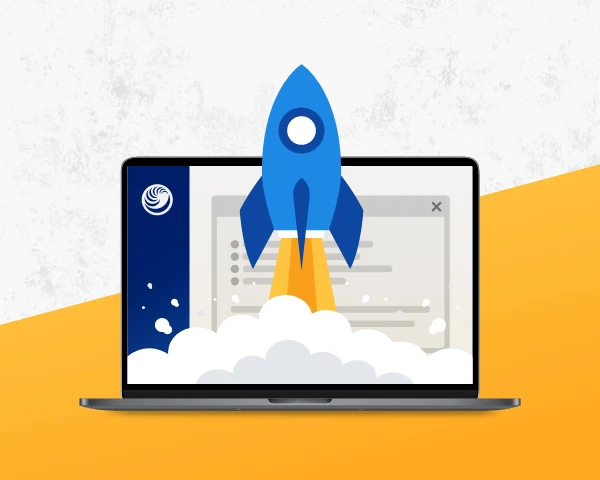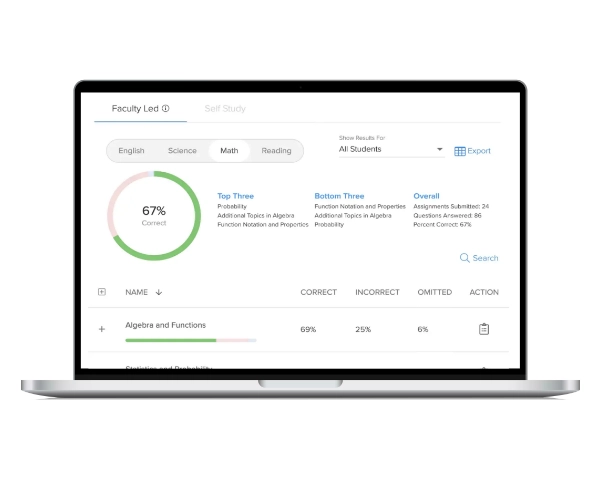There’s no denying that the move to a digital SAT® has many advantages. After all, it offers more flexibility in how the test is administered and makes it easier for students to access. Plus, taking the test digitally means a more personalized experience tailored to each student’s abilities and provides quicker scoring results.
Still, the transition from the traditional paper-based SAT to the Digital SAT is quite a significant shift in standardized testing. SAT changes are a big deal for teachers and school administrators, too, because not only do some states use the SAT as an accountability measure for graduation, but these changes also go hand in hand with the growing integration of digital technology in education. And so, these Digital SAT changes raise an important question: How can we, as educators, effectively prepare our students for this digital shift?
The Five Things You Need to Know
Answering this question can be a bit daunting—there’s a lot of information to go through about the Digital SAT, after all. That’s why we’ve taken the time to sort through the details—so you don’t have to. Here are the five key things you need to know to prepare your students for the Digital SAT effectively, ensuring they have a successful experience and the transition goes smoothly.
1. Format and Structure Changes
The Digital SAT represents a significant shift from the traditional paper-and-pencil format, primarily in its structure and delivery method. The digital version is divided into two sections: Reading and Writing, and Math. The overall duration of the digital SAT is shorter, too, lasting about 2 hours and 14 minutes, compared to the three hours and 15 minutes duration of the paper-and-pencil version. Each section of the digital SAT consists of two parts, with a scheduled 10-minute break between the two major sections. Time allocation for each section is also different—the Reading and Writing section is 64 minutes long, while the Math section is 70 minutes.1 Additionally, the passages in the Reading and Writing section are significantly shorter–25-150 words–than the long passages on the paper SAT, and each question will be paired with its own short passage.6
Key Takeaways:
- Features two sections: Reading and Writing, and Math
- Shorter duration: 2 hours and 14 mins
- Each section has two parts, with a 10-minute break in between
- Time allotted: 64 minutes for Reading and Writing, 70 minutes for Math
- Shorter passages: Each question in the Reading and Writing section is paired with its own short passage
2. Adaptive Testing
The Digital SAT is adaptive, meaning the test adjusts its difficulty based on a student’s performance. It uses a multistage adaptive testing design, where each test section is divided into two modules, and the difficulty of the questions in the second module depend on the student’s performance in the first module. This adaptive testing process aims to make the test more efficient, accurate, and tailored to each student’s abilities. The scores in an adaptive Digital SAT test are calculated through an equating process, and the test adapts between the modules, not within them.4
Key Takeaways:
- Digital SAT is adaptive
- Test adjusts between two modules
- Second module’s difficulty is based on the first module’s results
- Scores calculated via an equating process between modules
3. Scoring and Reporting Changes
Since the SAT transitioned to a digital format, there have been notable changes in scoring and reporting.3 Electronic score reports, revised for the digital test, now include a comprehensive assessment of a student’s reading, writing, and math skills. These reports are also designed to provide students with information about local colleges, training programs, scholarships, and more. Despite these changes, the SAT continues to be scored on the traditional 1600 scale, and scores from the digital format are equivalent to those on the paper-and-pencil version. While the test content has been adapted for digital delivery, it still evaluates the same key skills and knowledge as before.
Key Takeaways:
- Electronic reports assess reading, writing, and math skills
- Reports offer info on colleges, programs, and scholarships
- Scores still on a 1600 scale equal to paper exam
- Content adapted for digital test but still assesses same key skills
4. Math Section: Graphing Calculator
The Digital SAT allows the use of a calculator throughout the entire Math section, mirroring the way they are used in school and in the real world. The Math section includes 38 questions that must be answered in 55 minutes, and students are allowed to use most four-function, scientific, and graphing calculators. It’s important that students use the calculator strategically, however, as many questions may be solved more efficiently without it. The test platform itself has a built-in Desmos graphing calculator, and students are advised to be familiar with it if they choose to use it.5
Key Takeaways:
- Calculators are allowed throughout entire Math section
- Includes 38 questions within 55 minutes
- Students may use four-function, scientific, or graphing calculators
- Platform includes built-in Desmos graphing calculator
5. Digital Test Preparation Strategies
The Digital SAT’s new online format calls for a revised approach to preparation, highlighting the importance of understanding content changes and the new testing interface. To meet this demand, updated study materials are pivotal to success. Educators now rely on online courses, video tutorials, and comprehensive software for effective preparation. Platforms like UWorld provide realistic questions and detailed feedback, familiarizing students with the SAT’s new digital format and targeting each student’s opportunities for improvement.
Key Takeaways:
- Digital SAT needs digital prep materials
- Understanding content changes and new interface is pivotal
- Educators can prepare students with online tools, videos, and practice tests
- UWorld offers realistic practice questions, detailed feedback, and performance tracking

Key Takeaways
The Digital SAT is a testament to the fact that standardized testing is currently undergoing a big change. For educators, it’s important to embrace these changes and adjust to them accordingly. UWorld is dedicated to making sure that educators have the right tools to support their students through this transition in the best way possible. By embracing these exam updates, we can keep up with the latest trends in technology and education while successfully preparing our students for the Digital SAT.
References
- College Board. (n.d.). Structure of the digital SAT. SAT Suite of Assessments. Retrieved from https://satsuite.collegeboard.org/digital/whats-on-the-test/structure
- Strategic Test Prep. (2023, March 9). Best digital SAT prep resources. Retrieved January 19, 2024, from https://www.strategictestprep.com/post/best-digital-sat-prep-resources
- College Board. (2023). Digital SAT: Frequently Asked Questions. Retrieved January 19, 2024, from https://satsuite.collegeboard.org/digital/faq
- College Board. (2023, August 14). What is digital SAT adaptive testing? Retrieved January 19, 2024, from https://blog.collegeboard.org/what-digital-sat-adaptive-testing
- College Board. (2023). Calculator use in the Digital SAT’s Math section. Retrieved January 19, 2024, from https://satsuite.collegeboard.org/digital/whats-on-the-test/math/calculator-use
- College Board. (n.d.). What’s on the Test – Reading & Writing. SAT Suite of Assessments. Retrieved January 30, 2024, from https://satsuite.collegeboard.org/digital/whats-on-the-test/reading-writing




